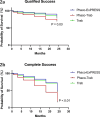Comparison of bleb morphologies between phacoemulsification combined with Ex-PRESS mini shunt implantation, phacotrabeculectomy and trabeculectomy alone: a two-year retrospective in vivo confocal microscopy study
- PMID: 38448910
- PMCID: PMC10916144
- DOI: 10.1186/s12886-024-03364-2
Comparison of bleb morphologies between phacoemulsification combined with Ex-PRESS mini shunt implantation, phacotrabeculectomy and trabeculectomy alone: a two-year retrospective in vivo confocal microscopy study
Abstract
Background: To compare the bleb morphologies of phacoemulsification combined with Ex-PRESS implantation (Phaco-ExPRESS), phaco trabeculectomy (Phaco-Trab), and trabeculectomy (Trab) in postoperative two years.
Methods: Patients with primary open-angle glaucoma (POAG) with or without cataracts were included in this study. All patients underwent surgeries of either Phaco-ExPRESS, Phaco-Trab, or Trab. The morphologic structures of the filtering bleb, including microcysts area, hyperreflective dot density, and stromal connective tissue under in vivo confocal microscope (IVCM), were compared between the three groups. The data were collected preoperatively and postoperatively at 2 weeks, 1 month, 3 months, 6 months, 12 months, 18 months, and 24 months.
Results: Eighty-nine eyes from 89 patients were enrolled, including 32 in the Phaco-ExPRESS group, 25 in the Phaco-Trab group, and 32 in the Trab group. In a 24-month follow-up, bleb morphologies in Phaco-ExPRESS were similar to the Trab group. The area of epithelial microcysts was significantly increased in Phaco-ExPRESS and Trab groups while significantly decreased in Phaco-Trab. At postoperative 24 months, the complete success rate was 65.1% in Phaco-ExPRESS, 32.0% in Phaco-Trab, and 59.4% in the Trab group (P = 0.03). The phaco-Trab group had more postoperative anti-glaucoma medications than the other two groups (P < 0.05).
Conclusions: Phaco-ExPRESS group and Trab group had similar blebs morphologies in IVCM, with larger microcyst area, looser connective tissue, and less inflammation than Phaco-Trab, indicating that the function of blebs in the Phaco-ExPRESS and Trab group, was more potent than that of Phaco-Trab. All these surgical methods provided adequate IOP control, but Phaco-Trab required more anti-glaucoma medications.
Keywords: Glaucoma drainage implant; In vivo confocal microscopy; Phacoemulsification; Primary open angle glaucoma; Trabeculectomy.
© 2024. The Author(s).
Conflict of interest statement
The authors declare no competing interests.
Figures






References
MeSH terms
Substances
Grants and funding
LinkOut - more resources
Full Text Sources

